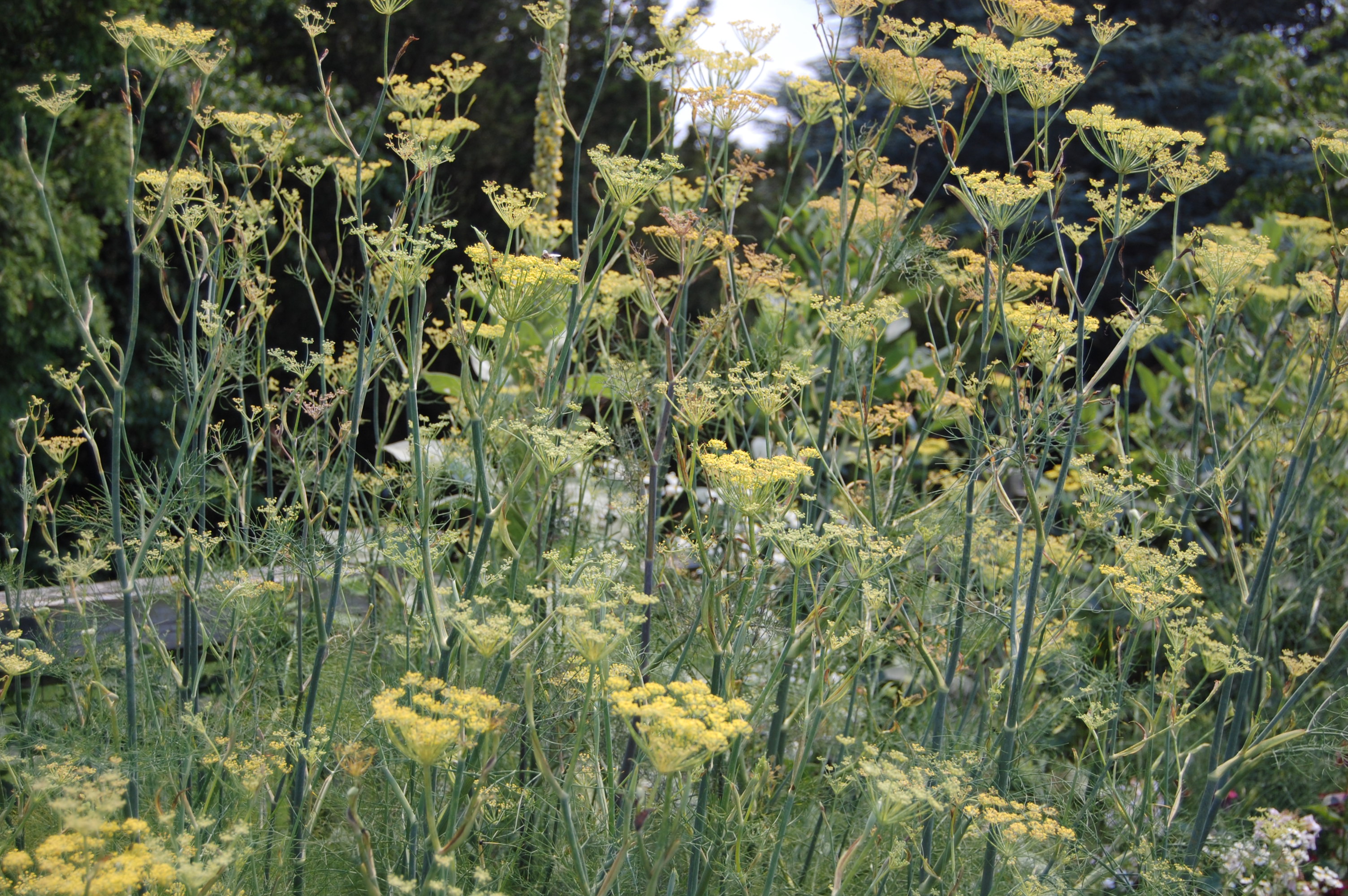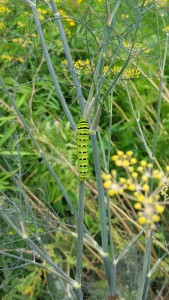Fennel, Foeniculum vulgare, is a short-lived perennial native to the Mediterranean area which has naturalized around the world. Because it freely reseeds itself, it is considered an invasive weed in the US and Australia. Fennel has been used for food and medicine since ancient times. It was used by both the Greeks and the Romans. It spread to Asia where it is an important ingredient in East Asian cuisines as well as an ingredient in the Chinese Five Spice Powder. It is one of the three herbs used in absinthe, originally a medicinal preparation which then became a popular alcoholic drink in the 19th century.
Fennel is often planted in butterfly gardens because it is the nectar plant of the swallowtail butterfly. This means that butterflies lay their eggs on the plants which then hatch into caterpillars which eat the plants. If you see damage on your plants, look for the green and black striped caterpillars which will morph into butterflies. I like to plant bronze fennel in my butterfly garden because of its wonderful bronze foliage.
There are three main types of fennel: sweet fennel, F. vulgare, bronze fennel, F. vulgare ‘Purpureum’, an ornamental fennel with bronze foliage and Florence fennel, F. vulgare Azoricum, which forms a bulb at the base of the stem that is eaten as a vegetable. In Italian it is called finocchio.
All three types of fennel taste similar to anise (Pimpinella anisum) although they are actually related to caraway (Carum carvi). Fennel, dill, caraway and anise are all members of the carrot family. Fennel has the characteristic umbel flowers of the carrot family. It looks like dill but with finer foliage. It will cross-pollinate with dill if planted too closely. The resulting plants will not taste like either parent.
Fennel needs full sun and well-drained soil. It has a long tap root making it a drought tolerant plant although in the wild it grows along riverbanks and near sea shores, as well as fields and other open areas. It is hardy in zones 4 through 9. Plants can grow to a height of 6 feet. They should be staked if grown in a windy location. Florence fennel is slightly shorter, growing to 4 feet.
Fennel is easily grown from seed. The seed should be direct sown in your garden rather than started indoors because it doesn’t transplant well due to its long tap root. Sweet fennel or bronze fennel seeds should be sown after all danger of frost has passed. Florence fennel seed should be sown mid-June to July depending on your growing zone to take advantage of the shorter days and cooler temperatures of late summer into fall. If sown earlier and grown during the hot days of summer, it will “bolt” or flower earlier which will have a negative effect on the flavor of the bulb. Germination for both types of seed is 12 to 18 days.
Sweet fennel should not be grown in rich soil or heavily fertilized. It should be grown in poor, well-drained soil for maximum taste. Florence fennel, which is grown for its bulb, should be planted in rich soil, well-fertilized and well watered. When the bulbs reach the size of an egg, you should begin to hill them up like you would leeks. This will give you whiter, more tender bulbs. The bulbs can be harvested when they reach the size of a tennis ball. Just dig them up, cut off the roots and stems and store in a cool place for up to three weeks.
Sweet fennel is grown for its foliage and seeds. The foliage can be harvested any time and used fresh or dried. To harvest seeds, allow the plants to flower and set seed. When the seed has turned brown, it is time to harvest it. I usually place a paper bag over the umbels, cut the stalks and allow the seeds to finish drying in the same paper bag with slits cut into it for ventilation. You can also wrap the umbels with cheesecloth, cut the stems and then place them in a paper bag (with slits cut into it for ventilation) to finish drying. The dried seeds should be stored in an airtight container, preferably glass. The container should be stored in a cool, dry, dark place.




25 Comments on “Fennel”
Pingback: 2017 Seed List – Postcards From The Pumpkin Patch
I saw fennel growing 8 or more feet high in a planter outside my hotel in London while visiting from Chicago and I wish to grow this in my planter. It might have been a bronze fennel. I would like the tallest ornamental fennel to grow in a planter as a perennial.Is there a preferred type that features more beautiful flowers?
Fennel is not an ornamental plant so its flowers will not be any more “beautiful” than what you saw in London. I always grow bronze fennel because the foliage is so attractive. I recommend you grow that one in your planter. The fennel you saw was extremely tall because they were probably fertilizing it. Fertilizing herbs is not recommended because it causes the plants to be tall, gangly and unhealthy. Fertilizing will also cause the plants to lose their flavor. If a gardener is growing fennel for cooking or medicinal uses, they should never fertilize it. If you are growing it as an ornamental, then you can fertilize to make it grow bigger if you wish but that may cause other problems such as disease or insect infestation because the plants will be significantly weakened by the fertilizer.
The fennel I planted a few years back was supposed to be Florence fennel but has never formed a true bulb, just a fatter, somewhat layered base. It grows up to 6 ft. high, has green, not bronze foliage and produces seed prolifically. Is there a way to get it to form bulbs or do I have a mislabeled plant? It readily reseeds and is growing in poor, gravelly soil. I live in Indiana, where frost comes as late as mid-May or again in late October with a cold winter.
The “bulb” in fennel is not a true bulb. It is a thickening of the base of the stem. Your fennel is forming a bulb, just not a large one like the ones you see in the grocery store. It’s probably due to the poor, gravel soil that it is growing in. To grow a large bulb, it needs fertilizer and plenty of moisture. Bulb-forming fennel has an 80 day growing season, so it sounds like your growing season is long enough. The problem is fertility and moisture.
Hi, Do adult fennel plants regrow their roots if removed and replanted elsewhere ?
You can transplant your fennel if you dig up the roots but if you harvest the “bulb” without the roots, and then replant it, it will not regrow its roots.
I love bronze fennel to eat but the seeds I found produce plants 4-6 feet tall. Is there a dwarf variety? If not, how do I keep it from becoming too tall, hard to manage and invasive? I do not want it become invasive.
Thanks very much.
Unfortunately, there is no way to control the size or spread of the plant and there are no dwarf varieties available. Grow this one in the back of your border and aggressively deadhead it so that it doesn’t produce seeds.
I planted what were labeled Smokey fennel a couple of years ago for my butterfly garden. The leaves had a bronze color when the plants were young but as they’ve matured, now three years later, the plants are all green. Otherwise they are very healthy. Could it be the soil conditions be causing this?
I am guessing that “Smokey Fennel” is just another name for bronze fennel and it is acting like bronze fennel, i.e. the new foliage is bronze but as it matures it turns the normal green color for fennel. There is nothing wrong with your plant or your soil. This is just how the plant grows.
Does bronze fennel release a substance that is toxic to other perennial plants? I want to plant in my pollinator garden but don’t want to damage other plants.
No, it does not. I have successfully grown it in a butterfly bed. It just prolifically re-seeds.
hello we have fennel in our greenhouse from last year. It never grew a bulb but it has many soft brown fuzzy fronds that look like animal tails and was wondering what the evolutionary advantage was to mimicking animals? the spread of seeds? to scare off predators?
thanks
What you have is bronze fennel. It is a non-bulb forming fennel. There is no evolutionary advantage to the bronze color. It is merely the color of the new foliage. You will observe that the foliage turns green as it matures.
I am considering growing fennel with my ornamental flowers. Currently I have coneflowers, milkweed, asters, hyssop and roses. I know fennel doesn’t grow well with other vegetables, but would it also inhibit the growth of ornamental flowers?
As far as I know, fennel is fine with flowers. Be sure to deadhead it. Don’t let it go to seed. It is a prolific self-sower.
I made the mistake of planting fennel in the same planer box as dill. Now I have hybrids. Can I use the bulbs (thick base) for a soup as I would true fennel?
If it is a hybrid, it will not taste the same as true fennel, but it is still edible.
I wasn’t able to find a picture of this in Winter – I plan on deadheading as you mention to prevent seeding, but am hoping to find something that looks nice through the Winter as well since most of my perennials die back.
Fennel also dies back in the winter. If you are looking for perennials that don’t die back in the winter, consider some of the woody ones like lavender, rosemary, sage and thyme.
Hello, I have a bronze fennel that was planted last fall in my garden. I planted it too close to my milkweed and wish to move it, but it is now covered in swallowtail eggs, which was my original purpose for planting it. Will it harm the eggs if I carefully transplant it into a large container? Thank you for any info.
BRonze fennel is not suitable for growing in containers because of its long taproot. I would not move it until after the eggs have hatched, the caterpillars have grown and made crysallises and become butterflies.
My husband planted bronze fennel in our butterfly garden, and the plants started out great, but for some reason they just wilted suddenly and fell over. Do you have any idea what could have been the problem? I have searched other websites but have not come up with an answer. We live in South Carolina where the temperatures have been quite hot and we have had a dry spell. My husband kept the garden watered, but I don’t think he was overwatering. Thank you.
Your husband may have been overwatering. Bronze fennel is a drought tolerant plant that likes to be dry. If it receives too much water, the roots rot and the plants die. Try watering less and see if the plants regrow.